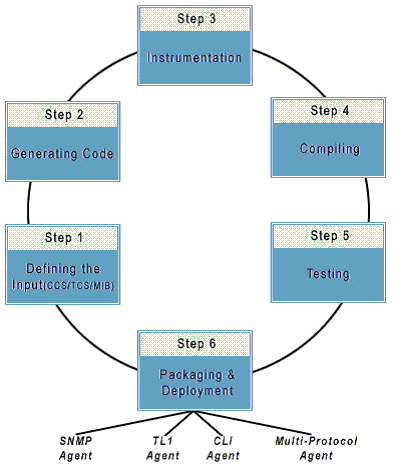Most of the management systems are built from top to bottom using SNMP, TL1, HTTP or CLI. They leverage the specific facilities offered by the selected management protocol. For example, OEM vendors are keen at SNMP for their management needs. Similarly TL1 is a man-machine management protocol deployed in broadband and access networks, including SONET networks. New technologies such as WDM and xDSL sometimes use the TL1 protocol for management of network equipment.
But these emerging OEM/Application/Enterprise vendors are worried about the rising cost of software development. This has forced them to look for productivity enhancing technologies. And in the current fast paced environment, it is not practical for most application developers to support multiple platforms and operating systems in a timely manner. A standard compliant management solution is required to allow rapid development of agents, for their devices/applications, making them suitable for network management
WebNMS Agent Toolkit C Edition is a rapid prototyping and development tool used for building SNMP, HTTP, TL1, and CLI Agents in ANSI C language. The Agent Toolkit primarily focuses on system management and device management and hence the run time agent is very modular, portable, and customizable. The toolkit provides multiple protocol access (including SNMP, HTTP, TL1, and CLI) to common instrumentation and these agents are called the multi-protocol agents. In addition to supporting multi-protocol agents, Agent Toolkit supports standalone SNMP, TL1, and CLI agents.
The agent source files are ported and well tested in Embedded Operating Systems, such as VxWorks, QNX Nutrino, Windows CE, OSE and other operating systems, such as Windows 95,98,2000, and NT, Solaris, Linux, Unix, Free BSD, Net BSD, HP-Unix, and OS-2. The agent source files can also be ported to other new OSs very easily, thus addressing the needs of fast paced environment for developing device/system management agents.
Step 1: Defining the Input for an Agent: MIB/TCS/CCS
Step 2: Generating code for the input
Step 3: Instrumenting the code for the desired function
Step 4: Compiling the generated source files
Step 5: Testing the developed Agent
Step 6: Packaging and Deploying the Agent

Cross-Platform: As a pure Java product, Agent Toolkit C Edition supports Solaris, Windows NT/2000, Linux, IBM AIX, HP-UX, and any operating system that supports Java.
Multiple Protocol Support: It supports SNMP, TL1, and CLI through standalone SNMP, TL1, and CLI agents. In addition to this, the toolkit supports multiple protocol (SNMP, TL1, CLI, HTTP, and other protocols) access to common instrumentation, called Multi-Protocol Agent.
Development and Test Tools: Agent Toolkit C Edition has a comprehensive set of easy-to-use command line and UI-based agent development tools, such as (editors, compilers, and browsers) for easy and fast development and testing of agents. Thus, it captures the complete user experience tools for "Define, Develop, Compile, Run, and Test”.
Time to Market: Easy-to-use development environment and powerful visualization tools simplify development process. Tangible improvements in development time and cost can be achieved by leveraging the core capabilities of the Agent Toolkit.
Reduced Cost of Development: The Run-time C agentsignificantly reduces your development costs, in terms of project costs and personnel for your product.